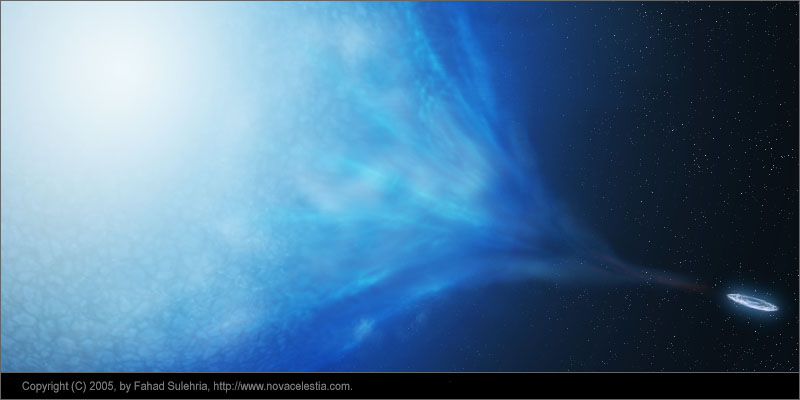| P7: Feeding the Monster: Wind Accretion in Black Hole Binaries |
 |
 |
 |
|
PhD Student: Ivica Miskovicova
Start Date: Jul 2009
The aim of this project is to use modeling and observations to study the accretion process in HMXB in greater detail. In the vicinity of the Back Hole, because of its high X-ray luminosity the accreted material is photoionized. As a result, the observed X-ray spectra from these systems show copious absorption lines, which are caused by the absorption of X-rays from the black hole in the ionized gas. These lines carry diagnostic information on the state of the medium, such as its ionization state and elemental abundances. Through observations of the black hole at different positions on its orbit around the companion star, the density distribution and the velocity profile of the stellar wind can be measured. Understanding these properties of the wider environs of the black hole is important for several reasons. First of all, such analyses allow us to define the "outer boundary condition" of the accretion stream that eventually produces the hard X-rays. Secondly, many of the predictions of processes next to the black hole, such as, e.g., the strength of the relativistic Fe Kα line, depend on our knowledge of the abundances of the accreted materia, and the strength and shape of the spectrum below 30keV depend on the metallicity of the accreted material. Thirdly, through detecting accretion disk winds and other outflow phenomena, these soft X-ray studies allow us perform independent tests on parameters inferred from other types of analyses. Successful applicants will be working with existing and new observations from Chandra and XMM-Newton and compare them with models developed to study the photoionization of the stellar wind next to the black hole. They will analyze how the parameters of the black hole spectrum influence the structure of the photoionized region around the black hole and apply these studies to the observational data. Working with Drs. Emrah Kalemci at Sabanci Universitesi and Rudy Wijnands in Amsterdam, they will also study the influence of the broad band spectral evolution over the outbursts of transient sources. An overview talk on the current state of the project as presented at the Collaboration Meeting in September 2010 in Istanbul can be found here. Related publicationsRefereednone yet available Other
none yet available |
 Black Holes produce their tremendous luminosities through the accretion of material from their stellar companion. In stellar mass black holes, two possible scenarios for this accretion mechanism are known: In Low-Mass X-Ray Binaries (LMXB) the companion is of low mass. During its evolution it expands until it fills its so-called Roche Lobe. When this happens, material from the companion star can fall onto the black hole via the inner Lagrange point, where the gravitational forces from the black hole and the donor star are equal. In this case, because the accreted material has a very high angular momentum, a large accretion disk forms. In this disk the accreted material moves on circular orbits. Inner friction caused by the viscosity of the material heats the accreted gas such that it radiates away part of its energy and slowly sinks deeper into the potential well of the black hole, until it falls through the event horizon. In High-Mass X-Ray Binaries (HMXB) the donor star is a high mass star. Masses of several 10 solar masses are common in these systems. Such stars have strong stellar winds. The black hole in these systems can then feed off the stellar wind. This process, also called Bondi-Hoyle-accretion, results in much smaller accretion disks, however, the mass accretion rate is still high enough to produce very luminous X-rays (several 10000 solar luminosities are typical).
Black Holes produce their tremendous luminosities through the accretion of material from their stellar companion. In stellar mass black holes, two possible scenarios for this accretion mechanism are known: In Low-Mass X-Ray Binaries (LMXB) the companion is of low mass. During its evolution it expands until it fills its so-called Roche Lobe. When this happens, material from the companion star can fall onto the black hole via the inner Lagrange point, where the gravitational forces from the black hole and the donor star are equal. In this case, because the accreted material has a very high angular momentum, a large accretion disk forms. In this disk the accreted material moves on circular orbits. Inner friction caused by the viscosity of the material heats the accreted gas such that it radiates away part of its energy and slowly sinks deeper into the potential well of the black hole, until it falls through the event horizon. In High-Mass X-Ray Binaries (HMXB) the donor star is a high mass star. Masses of several 10 solar masses are common in these systems. Such stars have strong stellar winds. The black hole in these systems can then feed off the stellar wind. This process, also called Bondi-Hoyle-accretion, results in much smaller accretion disks, however, the mass accretion rate is still high enough to produce very luminous X-rays (several 10000 solar luminosities are typical).